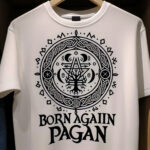The Christmas season is one of the most beloved times of year, and while many of us associate it with the Christian tradition, it actually has its roots in the pagan celebrations of long ago. In this article, we’ll explore the pagan history of Christmas and discover how many of the traditions we know and love today are rooted in ancient pagan practices. From the evergreen tree to the yule log, we’ll uncover the fascinating origins of the symbols and customs we now associate with Christmas.
Christmas is a time of celebration and joy for many, but it has a much older history than most people realize. In fact, its roots go back to ancient pagan festivals and winter solstice celebrations that pre-date Christianity. Christmas is an amalgamation of several traditions from different cultures and religions, and the origins of these ancient pagan customs are still debated today.
What is the Pagan History of Christmas?
The pagan roots of Christmas lie in the tradition of celebrating the winter solstice. This was a period of time in which the sun was at its lowest point in the sky, signaling the start of a new year and the return of longer and brighter days. The ancient pagans believed that the sun was being “born” and celebrated this event with festivals that featured feasting, singing, and gift-giving.
Many of these traditions have been incorporated into modern-day Christmas celebrations. For example, the ancient pagan tradition of lighting bonfires to celebrate the rebirth of the sun has been transformed into the modern practice of decorating a Christmas tree. Similarly, the ancient practice of exchanging gifts has been adapted into the tradition of exchanging presents on Christmas Day.
How Did Christianity Influence Christmas?
The early Christian Church was keen to incorporate pagan traditions into their own celebrations as a way of making Christianity more appealing to pagans. As a result, the celebration of the winter solstice eventually became associated with the birth of Jesus Christ. This transformation was made possible by the fact that the dates of the winter solstice and Christmas often fall close to each other.
The early Church also adapted some pagan symbols and rituals for use in Christmas celebrations. For example, the ancient pagan symbol of the Yule log was adopted and transformed into the modern practice of burning a Yule log in the fireplace as part of Christmas celebrations.
What Is the Significance of Christmas?
Christmas is an important time for Christians as it marks the birth of Jesus Christ. It is a time of reflection, celebration, and joy as Christians remember the story of Jesus’ birth and the joy that it brought to the world.
For many people, Christmas is also a time of giving and receiving gifts. This is a tradition that dates back to the ancient pagan practice of exchanging gifts to celebrate the winter solstice. The modern practice of exchanging presents on Christmas day is a reminder of the joy of giving and receiving.
What Are Popular Christmas Traditions?
Christmas is a time of celebration and joy, and many of the popular traditions we enjoy today have their origins in ancient pagan customs. Some of these traditions include decorating a Christmas tree, sending holiday cards, giving gifts, and baking festive treats.
Other popular Christmas traditions include decorating the home with festive lights, singing Christmas carols, and attending church services. All of these customs are reminders of the joy and hope that the winter solstice once brought to the ancient pagans, and are an important part of the modern-day Christmas celebration.
Conclusion
The pagan history of Christmas can be traced back to the ancient tradition of celebrating the winter solstice. This celebration was later incorporated into Christianity, transforming it into the modern-day Christmas celebration that we know and love today. The many traditions associated with Christmas are reminders of the joy and hope that the winter solstice once brought to the ancient pagans, and continue to bring joy and happiness to people all over the world.
Christmas is a holiday that has been celebrated for centuries, and its pagan roots still remain to this day. While many of the traditional symbols and decorations of Christmas have been adopted from pre-Christian cultures, the spirit of the holiday has remained the same: to celebrate the winter solstice and the return of the sun. Christmas is a time of joy, giving, and peace, and its pagan history is an important reminder of the importance of light, love, and community. We can all appreciate the beauty of this holiday and the traditions that have been passed down from generation to generation. Christmas is a time to come together, celebrate our shared history, and enjoy the warmth of the season.





